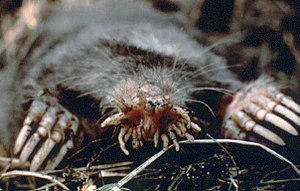Field Guide/Mammals/Star-nose Mole
< Field Guide | Mammals
| Condylura cristata (Star-nose Mole) | |
|---|---|
|
Family: Talpidae
Size: Total Length – 6.89 to 8.07 inches (175 to 205 mm); Weight – 1.23 to 2.64 oz (35 to 75 g) [1]
Description: The star-nose mole has a blackish brown appearance; their body is covered in black-brown water-repellant fur. Long tail, four large legs covered in scales. They have 11 pairs (22 total) of fleshy pink tentacles at the end of their snout that makes the nose look like a star.[2]
Similar Species: Unlike any other species; easy to differentiate with their tentacles on their nose.
Range: The main distribution range of these animals extends to the north-eastern US and eastern Canada. They are found in places like Labrador, Quebec, Minnesota, Indiana and South Dakota. These mammals can also be found along the Atlantic Coast and in the Appalachian Mountain area.[2]
Habitat: They are semi-aquatic animals preferring low wet areas. The tunnels of these moles often lead below water surfaces. They can be found in wet meadows, marshes, banks of streams, lakes and ponds.[2]
Diet: These small mammals feed on various small insects and fishes including ants, worms, beetles, molluscs and snails.[2]
Activity: Spends most of the time burrowing tunnels; this species is active by day as well as by night, spending about half of each 24 hour period resting or sleeping curled upright with the head bent under the forelimbs.
Reproduction: The breeding season starts in mid-March and continues through April. They reproduce once every year, but the females may reproduce a second time if their first litter is unsuccessful. One litter may contain 2- 7 offspring.[2]
Lifespan: 3 to 4 years in the wild.
Notes: The nose is the principal sensory organ of the Star Nosed Moles as they cannot see. The tentacles covering the edges of the nose contain 25,000 highly sensitive touch receptors. These completely hairless tentacles help them in hunting. They identify insects, invertebrates or any other consumable substance around them by the help of these tentacles. They hunt by touching their prey. It takes them very little time to decide if a substance is edible. The whole hunting process takes an average 230 ms (millisecond- a thousandth of a second) to complete once they find their prey.[2]
|
 |
- ↑ North American Mammals: Condyluracristata, retrieved 23 September 2012
- ↑ a b c d e f Star Nosed Mole, retrieved 23 September 2012